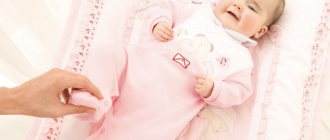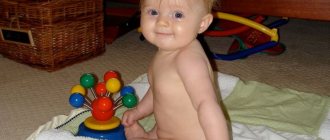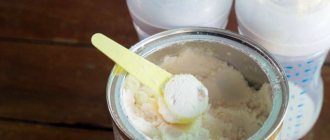Blanket for a stroller: dimensions
The main mistake when choosing a blanket is the desire of parents to buy something with a maximum margin for height. As a result, you end up with an overly bulky option that barely fits in the stroller. And simply wrapping a newborn tightly in such a blanket will not work: the baby will constantly open up.
When choosing a size, refer to the table:
| Age | Suitable Size(cm) |
| Newborns | 75x75 |
| 75x90 | |
| 80x90 | |
| Children under one year old | 95x100 |
| From 1 year to 3 years | 100x120 |
| 105x115 | |
| Over 3 years old | 110x140 |
The best option would be to purchase two models with different degrees of insulation. The smaller size is purchased for the newborn period, and the next one with the expectation of the next change of season.
Example 1
If the baby was born at the beginning of winter, he will need an insulated blanket 75 by 90 or 80 by 90 centimeters and a light one by summer 95 by 100 centimeters.
Example 2
For a child born at the end of spring, it is worth purchasing a light blanket 75 by 75, 75 by 90 or 80 by 90 centimeters and a warmer 95 by 100 centimeters for cold autumn and winter days.
- Do not take the blanket into the stroller with a reserve for growth.
- If possible, buy two options in different sizes depending on the month the baby is born.
- When choosing a blanket for a newborn, be guided by his height and weight at birth and the dimensions of the cradle.
How to knit a warm blanket for a baby
A suitable blanket must be selected for mothers who are being discharged from the maternity hospital during the cold season. It will protect the baby from the cold and prying eyes. Today there is a huge selection of such products: acrylic, wool, cotton. Different textures, fabrics, patterns and colors - the eyes run wild. You can choose any product depending on your preferences. However, give preference to natural fabrics so as not to damage your baby’s delicate skin.
Information for beginner needlewomen
If you want to knit a blanket yourself, but you have few skills, prepare for this process in advance. Study the forums of needlewomen who will help you with valuable advice, and prepare everything you need. Knitting a blanket is not at all difficult, but it is advisable to practice in advance and master the basic skills. Decide what you will knit with - crocheting or knitting. The hook forms more openwork loops, and with the help of knitting needles you will achieve greater density. The simplicity of the work lies in the fact that you don’t even need a pattern or difficult calculations.
In order to knit a neat blanket, select the required amount of yarn (it can be calculated depending on the knitting density and the size of the product), as well as knitting needles (their size also depends on the density of the loops you plan to make). As you work, be extremely careful not to miss a loop or to avoid any loose threads.
You can make a plain fabric, or you can make it two-color (knit with two threads at once or break it into diamonds). The second option is much more complicated and requires certain skills and dexterity. As for the parameters, the optimal size for a recently born baby is 80 cm in width and 110 cm in length.
Along with this they search and read:
Video: Blanket for babies with Cobweb pattern
Knitting a blanket with knitting needles
Let's try to knit a simple blanket. First, prepare 500 g of acrylic yarn. This material is easy to knit and is suitable even for beginners. We will need knitting needles number 3 or 5. We knit it with a garter pattern - all the loops must be knitted. To begin, make a hexagonal fragment according to scheme 1. An example of a triangular shape is number 2. The density of the product should be 12 by 12 centimeters - this is 30 points by 45 rubles, the length of the figures should be 20 cm. Ultimately we should get 22 pieces of samples that we tie together with eight loops.
We knit the first row in this way: one edge row, another knit one, one with a double crochet and six more, plus an edge row. We continue the work according to example 1. We knit 36 rows in this way and close the last one. We knit the halves in the same way, but the rapport must be repeated three times. Now we sew the edges of the hexagons. Sew on the first two fragments. For a triangular piece, pick up 40 loops from different sides. We knit the wrong part and begin to work on the second schematic pattern up to the seventeenth row inclusive. The eighteenth will be a purl, but the three loops need to be combined, and at the end the first one should be thrown over the second.
We knit other elements using the same pattern, after which we assemble the parts together. From the edges of the product, 200 loops need to be picked up and knitted in garter stitch, adding one loop ten times on each side of the second row. We sew the edges and admire the finished blanket. In order for it to take shape, wash or simply wet it. Now you can cover the little smart guy, who will probably not freeze under such a cape.
Rate: (1 votes, rating: 5.00 out of 5)
BabyBrainy.ru
Peculiarities
Material is the most important and important feature of children's knitted blankets. Previously, it was generally accepted that yarn should be exclusively natural, but now this opinion is outdated. This is due to the fact that yarn production has come a long way, so many synthetic materials with hypoallergenic additives have appeared.
To create a blanket for your baby, you can choose the following types of natural and synthetic yarn:
When choosing, try to find a yarn that is 50% natural and 50% synthetic.
Harmful microorganisms will not be able to grow in it, and caring for such material will not cause much trouble. With proper care, your product can last for many years. It is advisable that the yarn be marked “children’s”, because it is particularly soft and practically does not prick.
As for color, try to avoid loud and bright colors. Give preference to soft pastel colors. Pale blue, peach, lavender, pink, grass green, beige are perfect.
For knitting, you can choose either knitting needles or a hook. It all depends on your skills and desires. Knitting needles are a more common option, as it is generally believed that they work faster. But if you prefer a crochet hook, you can knit with it. When choosing knitting needles, remember that a blanket is not a small product, so most likely you will encounter fatigue and excessive tension on your hands. Choose circular knitting needles with a long flexible part for knitting a complete fabric, this will help you avoid problems with fatigue.
When you choose yarn, pay attention to the label. Most likely, the number of knitting needles that will be needed for knitting will be indicated there.
As for the plaid pattern, here you can show your imagination. But still, we would recommend adhering to the following tips:
- In order for a plaid to look stylish, you should not overload it with a large number of different patterns and embroideries. Stick to a simple design;
- A blanket that is too bulky may be uncomfortable for a small child;
- For older children, it is possible to choose a blanket with embroidery in the style of his favorite cartoon, using a pattern that is familiar to him. For example, a magic castle or a superhero emblem;
- Try to choose a pattern that looks good on both sides at once. Let it be a “checkerboard”, “stocking stitch”, “rice” pattern;
- A blanket made from leftover yarn will have a variety of textures, so be prepared for this;
- The canvas can serve not only to cover the child, but also serve as a rug. Make sure the blanket is of sufficient size.
Important characteristics of blankets for newborns
A blanket for a newborn baby is a very convenient multifunctional accessory. Let's try to understand its purpose and variety of types.
A blanket for a newborn can be actively used from birth to 6 months, and periodically until 1-3 years.
The main function is the same as blankets - to cover the baby. The difference is that the blanket is smaller in size and lighter than a blanket, and most often it does not have filler, it is single-layer.
Functionality
Usage options:
- as an envelope for discharge, and then for walks.
If the child was born in the warm season, then there is no need to buy an expensive holiday kit for discharge; a blanket will do the job perfectly.
By complementing it with a beautiful ribbon and bow, you can get an exclusive set, and, what is important, actively use it in the future; A warm blanket is not always appropriate, especially if the house is warm. However, babies sleep better covered, so a light blanket is what you need. In addition, it is convenient to take it with you on visits or on trips - a familiar thing will calm the baby down if he is fussy;
- like a bedspread.
To create a more aesthetically pleasing appearance of the crib, you can cover the crib to protect the bedding if it is the right size;
A blanket is indispensable in a stroller for walks - you can cover your baby with it when he is cool, rolled up you can put it under your head while feeding from a bottle, rolled it into a roll you can use it as a positioning pillow, and if the summer walk is prolonged, the mother can feed breastfeeding the baby, hidden from prying eyes. Due to its small size, the blanket is easy to take with you - when not needed, just roll it up to the size of the stroller and put it on the bottom, under the mattress - this will provide additional shock absorption on the roads;
- in the form of a play mat or toy for an older child.
It's no secret that many children become attached to things - a blanket or blanket is often such an attachment. This is understandable - a child often associates this accessory with a feeling of protection and safety, and he often values his blanket very much and refuses to fall asleep without it. Often it becomes a baby's very first favorite toy.
Varieties and materials
Blankets for newborns are varied. They are usually square or rectangular in shape; the corners can be straight or rounded to varying degrees.
In terms of sizes, the most popular are 75 cm x 75 cm, 100 cm x 80 cm, 100 cm x 140 cm.
Materials can be natural: Cotton yarn is most often used for knitted products. This type is environmentally friendly, antibacterial, hypoallergenic, hygroscopic and antistatic. Quite soft to the touch;
Natural wool for products intended for a baby is not the best option. Despite many advantages - hygroscopicity, thermoregulating properties, healing effect, wool has a significant drawback - it is an allergen.
Or synthetic:
Acrylic yarn is cheap and hypoallergenic, unlike wool, but tends to stretch and lose shape with frequent washing. Soft to the touch, but “creaky”;
The material is of synthetic origin, hypoallergenic, warm, lightweight, incredibly easy to care for. Among the disadvantages - it tends to accumulate static electricity; A very delicate and soft material of synthetic origin, its properties are similar to fleece, but it feels much softer to the touch.
It is better to choose colors for a baby in pastel colors, without bright designs or patterns. Delicate peach, beige, blue and pink tones are great.
Attention! You should avoid the presence of small decorative elements on products for young children - buttons, bows, snaps, etc. The presence of small decorative elements is unsafe for health, as they may end up in the baby’s respiratory tract.
Manufacturers
Swaddle Designs. The company specializes in products for newborns, therefore it ensures strict quality control at every stage of production. Offers blankets for newborns made of fleece with silk edging around the edges. Stylish modern prints and delicate patterns are suitable for both newborns and older children. Size – 100 cm x 75 cm. Price from 4100 rubles.
Gloria Small. Russian manufacturer offers lightweight cotton knitwear with prints and inscriptions. Size 90 cm x 90 cm. Price from 600 rubles.
Luxberry. A manufacturer from Portugal offers knitted openwork blankets made of soft wool with polyamide in a ratio of 80% to 20%. Size 100 cm x 150 cm. Price from 2500 rubles.
Klippan. The Swedish manufacturer offers products made from merino wool (60%) and lamb wool (40%) measuring 65 cm x 90 cm. Price from 2100 rubles.
Handmade knitted blankets for newborns are very popular now. You can knit it yourself or order it from craftswomen, you can knit or crochet, on a knitting machine or by hand, you can choose the wool composition, size and design.
Care instructions
Care, like all children's things, should be simple and undemanding, since children's things need cleaning much more often than adults.
Care Tips:
- carefully study the information on the label, since care features directly depend on the composition of the product;
- do not use dry cleaning, as the baby may have an allergic reaction to the components of cleaning products;
- most often machine washable at 30 degrees in a mode for delicate fabrics;
- wash the blanket at least once every 7-10 days with daily use;
- use only special children's products for washing, with a minimum content of various fragrances and aggressive components;
- do not dry on the radiator;
- It is better to iron through damp gauze.
© 2021 textiletrend.ru
textiletrend.ru
Which size should I choose?
You can choose absolutely any size. If you plan to use a duvet cover, then focus on it, but usually no one uses this option. Below we provide basic guidelines that will help you determine the size of your product:
- Choose a meter by meter size to use the blanket in the stroller;
- The square shape is suitable for wrapping a baby. For example, for discharge;
- In order to only cover the baby, select a rectangle shape;
- Look at the size of a standard baby blanket. Focus on it if you are knitting a blanket only to use it in the crib;
- The standard size of a blanket for the little ones is 80 cm wide and 100 cm long;
- Remember that children grow very quickly, so knit a blanket “with reserve”, otherwise it will quickly become unnecessary.
How to knit a baby blanket with knitting needles. Master class for beginners
Yarn: “Svetlana” produced by “Semyonovskaya Yarn”, 250 m / 100 g, 50% wool, 50% acrylic. Yarn consumption: 350 g. Tools: circular knitting needles No. 3, knitting needle. Knitting density: main knitting Pg = 2, 25 loops in 1 cm, Pv = 3.2;
garter stitch Pg = 2.14 loops per cm, Pv = 4.3 rows per 1 cm. The blanket for a newborn is knitted from soft wool blend yarn in the color “Apricot”. A simple double-sided pattern of knit and purl stitches was used as the main knitting (see knitting pattern for the pattern). The finishing strips along the edge of the blanket are knitted in garter stitch. This blanket is very easy to knit.
If you knit a blanket from yarn in bright and pure colors, your baby will definitely love it.
Loop calculation
To calculate the number of loops that need to be cast on the knitting needles for knitting a blanket, it is necessary to determine the knitting density of the main and garter stitch. Find out more about how to determine knitting density.
When calculating loops, we must take into account the desired size of the product and pattern repeat. As for the size, the standard size of a baby diaper is 80 x 80 cm, we will focus on it. We need the pattern on the blanket to be symmetrical.
Therefore, you need to add loops to whole repeats for symmetry of the pattern. You also need to take into account the width of the slats along the edge of the blanket. We will knit strips 2.5 cm wide, this is 7 loops (including the edge stitch). This means that we need to knit 80 - 6 = 74 cm with the main knitting.
note
One repeat of the main pattern is equal to 18 loops or 8 cm. For symmetry, we need to add half a repeat, i.e. 9 loops or 4 cm. It turns out that for whole repeats there are 74 - 4 = 70 cm.
Let's determine the number of whole rapports: 70: 8 = 8.75, round to the nearest whole number, we get 9 rapports. So, the number of loops in the main knitting :
9 (number of whole repeats) x 18 (number of loops in a repeat) + 9 (number of loops for pattern symmetry) +7 (number of loops for one strip) x 2 = 185 loops.
But we know that the knitting density (Pg) of finishing garter stitch is less than the main one. This means that so that the bar along the bottom is not too loose and does not look stretched, we need to recalculate the loops.
Let's clarify the final size of the blanket: 185 (number of loops) x 2.25 (Pg of main knitting) = 82 cm.
Now let’s determine how many loops need to be cast on the knitting needles:
82 (piece size) x 2.14 (Pg garter stitch) = 175 stitches .
Sequence of work
So, we put 175 stitches on the knitting needles using the basic method and knit 11 rows in garter stitch. We will decorate the edge a little differently than usual: we will not remove the first loop in the row, but we will knit the front one behind the back wall.
We bring the working thread down and back We knit a loop behind the back wall of the front
We knit the last loop in the row as usual, using a knit stitch.
In this case, the edge of the edge will stretch more. Considering that the horizontal knitting density (Hg) of the main knit is less than that of the finishing knit, this will allow the bar to stretch and compensate for the difference.
If the knitting densities of the main and finishing knits differ significantly, we recommend knitting the bar in shortened rows. Read more about it and watch the video.
Important
In the 11th row we will make straight yarn overs to add loops. In total we need to make 10 yarn overs to make a total of 185 loops. We make additions evenly. We knit 11 loops (including the edge loop), make a straight yarn over, and then make yarn overs through 18 loops. It is more convenient to make the last yarn over in front of the bar. The scheme for adding loops is as follows:
11 knit, *yo, 18 knit* - repeat 8 times, yo, 13 knit, yo, 7 knit.
In the next row we move on to the main pattern. At the beginning and end of the row we knit 7 loops in garter stitch and then with the main pattern. We knit the yarn overs behind the back wall, without openwork, so that the increase is unnoticeable.
In order for the blanket to be square in height, we need to knit 11 repeats (264 rows) with the main pattern. In the last row we decrease 10 loops in the same places where we added them, knitting two loops together with a tilt to the left. We tie the bar and close the row in the classic way.
Beautiful and soft children's blanket knitted
Video tutorial on knitting a baby blanket
Other patterns suitable for baby blankets
Click on the picture to go to the diagram.
Source: https://knitplanet.ru/children/vyazanie-dlya-novorojdennih/kak-svyazat-detskiy-pled-spicami
Popular models
Children's knitted blankets made from Limbazhu yarn look very beautiful. This is a rather rare yarn from the Baltic Latvian factory. It contains wool from New Zealand sheep. This yarn is quite difficult to find in regular stores; it is purchased to order. Knitting from such wool is distinguished by unique shades, brightness and original combinations.
The product knitted from limbazhu is light and airy. In terms of consumption, it is quite economical. Its peculiarity is its change after washing. Each thread becomes more voluminous, do not forget to take this into account when knitting.
No less popular are blankets knitted from cashmere. Canvas made from such yarn looks very noble and expensive. Light and airy material retains heat perfectly, so it will warm your baby even in the coldest weather. You can often find blankets made by adding silk or other yarn to cashmere. This is also a great option.
This material turns out smoother, silkier, with slight pleasant roughness.
The following options are also popular:
- Openwork plaid. A satin ribbon, an intricate knitted pattern, a lot of ruffles - this is what an openwork plaid is. This product looks very luxurious, most often it is chosen for girls;
- Blankets created using knitted squares sewn together look very cute. This type of knitting can be done both crocheted and knitted at the same time. You can use squares of different sizes, small pom-poms, squares of different textures. It all depends on your imagination.
Examples of yarn consumption for children's blankets
Now let's look at various examples of the amount of material needed. For knitting needles and crochet hooks these will be different values.
A combination of different weaves: openwork and aran looks good in such a product.
Openwork and arans
The dimensions of this blanket are 1x1.2 meters. To implement this, you will need yarn with a composition of 60% cotton/40% acrylic with parameters of 150 m/50 g. In total, you will need approximately 10–11 skeins, i.e. about 1700 meters.
Shadow stitch
In the next variation, the pattern is formed by alternating knit and purl stitches.
- Dimensions: 122x153 cm.
- Material: yarn 55% cotton/45% polyacrylic 300 m/100 g.
- Flow: 1000 m.
From individual motives
The next option is obtained by knitting individual elements that are assembled into a single fabric.
- Size: 110x110 cm.
- Material: 100% cotton with parameters 400 m/100 g.
- 1800 m will be required.
Crocheted fabric requires more material to create than a knitted product of the same size. But it looks more delicate and light.
Simple option
- Size: 95x95 cm.
- Material: 55% cotton/45% polyacrylic 320 m/100 g.
- How much material is needed: 300 g.
- Size: 88x88 cm.
- Material: Pekhorka “Children’s novelty” 100% acrylic 200 m/50 g.
- Consumption: 350 g.
All data can be considered as rough guidelines.
Interior ideas
A blanket can perform not only its usual functions, but also perfectly complement the interior of the room. Using a blanket to cover the crib looks very nice. Below we will look at the most beautiful ideas for using a blanket in the interior:
- For a boy, a soft blue color in a bright room will serve as the finishing touch to the entire interior. Choose several soft toys or pillows to match the blanket. Let the interior of the room be solid;
- A blanket knitted with a bunny pattern is the cutest option you can have. Complete this product with knitted ears. Pastel colors will add even more softness and tenderness to the interior. Use a small pompom for the bunny's tail and use your imagination to create a unique design.
- The product can be made not with one bunny, but with a pattern of several. This option also looks quite good; there are usually no problems with describing and executing such a scheme;
- Loin knitting technique. This method allows you to create knitted designs on the product. For example, this could be your baby's favorite character. Maybe the interior of the children's room already has motifs from your favorite cartoons, why not repeat this idea when creating your bedspread;
- Plaid of squares. When creating such a product, you can move away from soft and pastel colors. Use bright, rich yarn. This blanket looks best in a nursery for older people.
If you have sufficient knitting skills, try using a technique where you create another one of a different shape from several squares. This is quite complicated, but such a product looks very interesting;
- A knitted blanket with hearts is an ideal option for creating a room for a girl in the style of a little princess. If the child's room is made in pink or light colors, then use yarn of a brighter shade to create contrast. You can highlight any element of the room by making a blanket in the same color.
How to decorate?
Before you start decorating your product, pay attention to your baby. If it is very small, then put off the decor for later, because small details can be a source of danger. If your baby is at an older age, then consider the following options for decorating a knitted blanket:
- Ribbons. To make the product look finished, use a satin ribbon around the entire perimeter of the canvas. Ribbons in contrasting colors look very nice. White and pink, blue and green, red and white - try experimenting;
- Pompoms and tassels. Decorate the blanket with small tassels of the same yarn or small pom-poms. You can decorate the edges of the blanket with them, or use pom-poms on the canvas itself;
- Bows. Buy ready-made bows or sew them yourself, for example, from satin ribbon;
- Buttons. Buttons look interesting in the design of a blanket. Choose a suitable color or use a contrasting one.
You will learn more about how to knit a children's blanket yourself in the following video.
Processing the back of a baby blanket (optional)
In some cases, the wrong side of the blanket is reinforced with a lining. This, as they say, depends on who you like. Some babies like it without a lining. Read about this cute blanket below, this is a bonus.
And if you choose the lined option, here are some tips.
For lining, choose:
- cotton fleece, or Italian anti-pilling fleece. It does not roll, does not stretch, very wear-resistant
- bike, you need to choose a soft one of good quality. Girls with experience in knitting lined children's blankets recommend American baize. They don’t sell this kind here, but they sell the Kirkiz one, it’s also good
- cotton jersey. I like Turkish, cute colors and easy to wear
- Before cutting, the fabric needs to be washed and ironed so that it shrinks as much as it needs.
- The lining is sewn on by hand, with a hidden seam, so as not to pull the knitted fabric. The fabric needs to be folded and ironed to make it easier to sew along the finished fold.
Benefits of knitted blankets
In addition to the warmth of mother’s hands and original design, a knitted blanket for a newborn has useful qualities for mother and baby:
- Will serve as a beautiful blanket in a baby's crib;
- It is convenient to use it on a walk and to cover the baby when he sleeps in the summer;
- A soft knitted blanket can be used as a pad between a mattress and a sheet. This coating will add softness and warm you in winter;
- Knitted blankets for newborns, knitted for discharge, will clearly highlight the child’s clothes with their originality and unusual texture;
- When the baby grows up and plays on the floor, such an item will turn into a comfortable rug.
Important! A knitted blanket for a newborn is made using simple knitting techniques, and the process does not involve arranging complex-shaped parts, so even a novice craftswoman can handle it.
Preparing for knitting
Before starting work, you need to choose a knitting method (knitting or crocheting), suitable threads and decide on the dimensions of the product.
Knitting needle selection
If the fabric is solid, then the knitting needles should be long enough, since the size of the blanket is relatively large. The exception is fabrics sewn from separately knitted squares and stripes. When the length of regular knitting needles is not enough, you can use circular knitting needles.
The size of the knitting needles in diameter depends on the desired thickness of the product, the selected threads, and the knitting pattern. The most frequently used:
- numbers 2.5; 3; 3.5; 6, if straight knitting needles are used;
- numbers 3.5; 5; 7 when using circular ones.
Important! Typically, the numbers of knitting needles used to use a given type of thread are indicated on the yarn label.
Which yarn to choose
To make a blanket for a child with your own hands, you need to choose a yarn that will be safe for the baby and provide him with comfortable warmth in accordance with the weather conditions:
- for summer - light threads;
- for winter - thicker, containing wool and other warm components.
For beginners: how to knit a blanket correctly | Schemes and descriptions
Autumn is a great time of year to sit comfortably on the couch and read an interesting detective story or watch a good TV series. But the main thing is to wrap yourself in a blanket! Plaid, in general, is the main home attribute of autumn.
Of course you can buy it. The stores have a huge assortment for every taste and color. And the prices are the most affordable. But it's boring. It is much more interesting to do everything yourself.
Therefore, in this article we will talk about how to knit a blanket with knitting needles.
* There are a lot of diagrams in the article, it may take a little longer to load. All knitting patterns are clickable and unfold in full size.
In fact, you can knit a blanket with anything, you can even sew it. You can even use the patchwork technique. There are plenty of options. But since we are considering the simplest options for beginners, we will focus exclusively on knitting needles.
How to knit a blanket with knitting needles?
A blanket is the simplest thing you can knit with your own hands. Easier, perhaps, is a scarf. Also, knitted blankets are cozy and pleasant things.
However, before you start knitting, there are a few things to consider:
- The wrong side of the product will also be visible, so it is best to choose double-sided patterns for knitting a blanket.
- In order for the finished product to take on a finished look, the edges should be processed. It can be trimmed with bias tape, or crocheted or knitted. Or you can knit the strips right away. Whatever is more convenient for you.
- The thicker the yarn and knitting needles you take, the faster you will knit the blanket.
- If the product is too wide, it is better to use circular knitting needles.
- By the way, it’s a very good idea to decorate the wrong side of a knitted blanket with fabric. Then you can choose absolutely any design.
So, in order to knit a blanket with knitting needles, we first need:
- decide on the size (the standard size of blankets is 150 by 200 cm),
- choose knitting needles, pattern and yarn.
To make an accurate calculation, take knitting needles (the most convenient size is from 2.5 - 3 to 5, but in general it’s a matter of taste and yarn, the thicker it is, the thicker the knitting needles) and knit a small square with the chosen pattern. This is done in order to understand how many loops and rows are needed per square centimeter. After this, you can already do the calculation and cast on the required number of loops.
How to knit a blanket from motifs?
Motifs can be used to knit blankets not only with crochet, but also with knitting needles. But there are some secrets here:
- decide on the dimensions and knit a test square to make an accurate calculation;
- select the desired colors and pattern;
- draw a pattern of alternating motifs on graph paper or a regular sheet of squared notebook.
Knitting patterns
Various knitting patterns can be found on the Internet or in magazines. Experienced craftswomen are able to come up with them themselves.
Knitting fabric
Beginners need to choose the simplest schemes. It is good to use the “Putanka” pattern for knitting with woolen threads, where the front and back loops alternate:
Pattern pattern "Putanka"
- Cast on the calculated number of loops;
- Several rows are knitted using garter stitch (knit stitches);
- To maintain a strip of equal width around the entire perimeter of the product, you must first knit as many knit stitches as there are rows of garter stitch. Then move on to the “Putanka”, alternating knit and purl loops, and finish again with the same number of knit stitches;
- Continue until the blanket reaches the desired size, using garter stitch again for the last few rows.
The simple pattern below is for knitting a plush blanket for a newborn with your own hands.
Pattern for a plush blanket
Instructions
The important steps in creating a knitted blanket for a child with your own hands are the first (set of loops) and the last (closing).
Start knitting
Description of the sequence of actions when casting on loops:
- You need to start not from the end of the thread, but by unwinding a small section (at the rate of 40 cm for approximately 15-20 loops);
- Hold the closed knitting needles in your right hand, the thread in your left;
- Wrap the index finger of your left hand with the working thread, and hold it with the other fingers of your half-open palm so that it can move freely.
Next proceed according to the scheme shown in the figure.
Set of loops for knitting needles
After casting on the required number of stitches, pull out one knitting needle.
Final stage
The loops are closed according to the following scheme.
When the work is completed, the ends of the thread are sealed.
Pattern options
For children's blankets, simple, repeating patterns are suitable, the elements of which will not be large.
Several possible schemes:
Diagram of the "Rhombus" pattern
- Network;
Scheme of the Braided pattern
- Braids.
Scheme of the “Pigtails” pattern
You can knit not only plain blankets: traditionally blue for boys, pink for girls, but also colored ones. For example, make multi-colored squares with different patterns, and then sew them together.
Blanket of colored squares
Plaid decoration
You can add decorative elements to knitted blankets for newborns. This should be done after washing and drying the finished product. Ribbons, lace and other materials are used for decoration. They need to be sewn on using monofilament thread due to its exceptional strength. Otherwise, the decorative elements may partially come off, and the blanket will lose its elegant appearance.
Knitted blankets for babies are good because they can serve several children and become a real family treasure. They will not only decorate the stroller, but will also be a useful thing for the child.
Blanket for newborns: necessary characteristics of materials, tips for choosing
The arrival of a baby in a family is a long-awaited joy. All family members want to make the life of mother and child as comfortable and beautiful as possible. A good purchase for this important event is a blanket for newborns. Despite the name, it will be useful not only in the first month of a baby’s life, but also for the next few years.
Blanket for newborns - is it necessary?
A blanket will warm a child
Representatives of the old Soviet school may be perplexed: “Before, there were no blankets for children, they raised children - and nothing.” It is appropriate to recall that, in fact, there were no blankets. We used light blankets. They were harsh and uncomfortable. Textile workers did their best. Mothers of children often used scarves and shawls from grandmothers. In the summer, the lucky ones covered the baby with a terry sheet, if they could “get one.”
The need for lightweight children's blankets and blankets has always been and is.
- A blanket for newborns is needed in the summer when mother and baby are discharged from the maternity hospital.
- You can cover a child with a blanket in a room or inside a car, or make a crib.
- You can throw it on the stroller while walking outside at any time of the year, except in harsh winter.
- It is convenient to lay a blanket on the floor for a slightly older child to play with toys.
By purchasing a blanket for your baby, you will provide him with comfortable living conditions in any environment.
Characteristics of blankets for newborns
Currently, a huge number of products for small children are offered to the attention of buyers.
Shapes and sizes
Blankets for newborns are made square, rectangular, with sharp and rounded corners.
Square blankets often have side dimensions of 100 cm, 120 cm.
Among rectangular blankets, the most popular are products in sizes 100x80 cm, 100x140 cm.
Colors
Blue plaid is traditionally for boys
When choosing the color of a plaid, buyers usually choose pink and blue colors. The motives are known to everyone. We recommend not to be guided by generally accepted considerations.
It is important to create pleasant feelings for mother and baby!
Choose any color you like. It will be better if it is not too bright. At first, the child has enough other impressions, and the presence of bright dyes in household items is of no use to the baby.
What are they made from?
Various raw materials are used to produce children's blankets.
Natural raw materials
Natural products are always in great demand.
- Soft products are made by knitting from cotton yarn. They allow air to pass through well, absorb moisture, do not cause allergies, do not electrify, and are hygienic. Cotton is an ideal raw material for any children's products.
- Manufacturers offer blankets for newborns made from natural wool. In places with a harsh climate, such a cape will retain heat well and keep the baby warm. Wool, like cotton, is breathable and hygroscopic. The healing effect of woolen materials is known. The ability of natural wool to provoke allergies is alarming. If there is a hereditary predisposition to such reactions in the family, it is definitely not worth the risk.
Synthetics
Synthetic raw materials for products in this group include acrylic, fleece, and velsoft.
- Acrylic blankets are soft, pleasant to the touch, do not cause allergies, and are inexpensive. With prolonged use and regular washing, acrylic products may lose their shape and visual appeal. A feature of products made from polyacrylates is “creakyness”.
- Soft, warm, beautiful blankets for newborns are made of fleece. They are very easy to care for and do not lose their external qualities. The trouble lies in the ability of some fleece products to become electrified.
- Velsoft baby blankets have good consumer qualities. The material is softer to the touch than fleece, very gentle, comfortable, safe.
Mixed raw materials
Moms like blankets made from mixed materials: cotton and acrylic, wool and polyamide. Products have appeared that include silk, bamboo, and micromodal.
There are imported and Russian products for children on the domestic market.
- Swaddle Designs is a reputable American company. Fleece blankets from Swaddle Designs will keep your baby comfortable. The products undergo thorough testing and are absolutely safe for the health of the baby.
- The Russian company Gloria Small produces wonderful cotton blankets. The products have interesting colors, are safe, hygienic, and inexpensive.
- The Portuguese company Luxberry offers knitted blankets that combine wool with polyamide fibers. The price of imported products is significantly higher than domestic ones.
- Swedish manufacturer Klippan makes blankets by combining wool from Merino sheep and lamb. The product is distinguished by its ability to retain heat well. It costs expensive.
How to care for newborn blankets
All children's products require constant, careful care, which should be simple and not take up much time from parents.
- Carefully study the manufacturers' advice and strictly follow it.
- There is no need to take children's clothes for cleaning.
- It is usually recommended to wash products for babies in a machine using the “delicate” program.
- If used regularly, wash the blanket once a week.
- Air dry flat.
- If the blanket needs to be ironed, do it through a damp, thin cotton cloth.
A blanket for newborns will be a good help in providing comfort to the baby. Purchasing certified products from reputable manufacturers guarantees quality and safety.
textile.life











